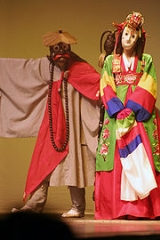
Important Intangible Cultural Properties
Encyclopedia
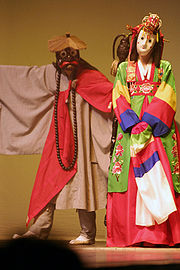
South Korea
The Republic of Korea , , is a sovereign state in East Asia, located on the southern portion of the Korean Peninsula. It is neighbored by the People's Republic of China to the west, Japan to the east, North Korea to the north, and the East China Sea and Republic of China to the south...
has officially designated for preservation since the inception of the program in 1964. They are proclaimed and maintained by South Korea's Cultural Heritage Administration
Cultural Heritage Administration
The Cultural Heritage Administration or CHA, formerly the Cultural Properties Administration, is an agency of the South Korean government charged with preserving key aspects of the Korean cultural heritage. It is headquartered in the city of Daejeon at the Daejeon Government Complex...
.
The first item so designated was Jongmyo jeryeak, the ancient music and dance performed at the Jongmyo
Jongmyo
Jongmyo is a Confucian shrine dedicated to the memorial services for the deceased kings and queens of the Korean Joseon Dynasty. According to UNESCO, the shrine is the oldest royal Confucian shrine preserved and the ritual ceremonies continue a tradition established since the 14th century...
Royal Ancestral Shrine in Seoul
Seoul
Seoul , officially the Seoul Special City, is the capital and largest metropolis of South Korea. A megacity with a population of over 10 million, it is the largest city proper in the OECD developed world...
; it was proclaimed on December 7, 1964. The most recent, announced on November 16, 2006, was Important Intangible Cultural Property 119, geumbakjang (gold leaf
Gold leaf
right|thumb|250px|[[Burnishing]] gold leaf with an [[agate]] stone tool, during the water gilding processGold leaf is gold that has been hammered into extremely thin sheets and is often used for gilding. Gold leaf is available in a wide variety of karats and shades...
decoration), practiced in Seongnam
Seongnam
Seongnam is the second largest city in South Korea's Gyeonggi province after Suwon and the 9th largest city in the country, with a population of nearly 1 million...
, Gyeonggi-do
Gyeonggi-do
Gyeonggi-do is the most populous province in South Korea. The provincial capital is located at Suwon. Seoul—South Korea's largest city and national capital—is located in the heart of the province, but has been separately administered as a provincial-level special city since 1946...
.
A similarly named yet distinct designation, "Intangible Cultural Properties," also exists, with 33 items having been proclaimed. These are proclaimed by provinces or cities rather than by the national Cultural Heritage Administration.
Proclaimed 1960-1969
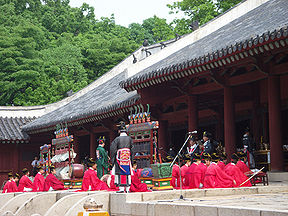

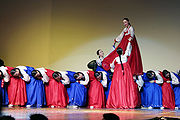
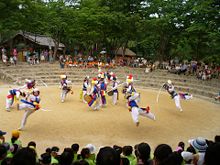


| No. | Title | Original name | Description | Location |
|---|---|---|---|---|
| 1 | Jongmyo jerye Jongmyo jerye Jongmyo Jerye or Jongmyo Daeje is a rite held for worshipping the late kings and queens of the Joseon Dynasty in Jongmyo Shrine, Seoul, South Korea. It is held every year on the first Sunday of May. The Jongmyo rite is usually accompanied with the court music playing and dance called Ilmu or line... ak |
종묘제례악 (宗廟祭禮樂) | Jongmyo Jongmyo Jongmyo is a Confucian shrine dedicated to the memorial services for the deceased kings and queens of the Korean Joseon Dynasty. According to UNESCO, the shrine is the oldest royal Confucian shrine preserved and the ritual ceremonies continue a tradition established since the 14th century... royal ancestral Confucian memorial ceremony music |
Seoul Seoul Seoul , officially the Seoul Special City, is the capital and largest metropolis of South Korea. A megacity with a population of over 10 million, it is the largest city proper in the OECD developed world... |
| 2 | Yangju byeolsandae nori Yangju byeolsandae nori Yangju byeolsandae nori is Korea's traditional mask playing which is selected as the second Important Intangible Cultural Properties of Korea next to Jongmyo jerye. It has played primarily in April , May , July and August and also sometimes in the ceremony which prays for rain... |
양주별산대놀이 (楊州別山臺놀이) | Byeolsandae mask dance-drama of the Yangju Yangju Yangju is a city in Gyeonggi Province, South Korea. Yangju is located south of Dongducheon and north of Uijeongbu not far from Seoul.- Attractions:... region |
The Wide area of Gyeonggi-do Gyeonggi-do Gyeonggi-do is the most populous province in South Korea. The provincial capital is located at Suwon. Seoul—South Korea's largest city and national capital—is located in the heart of the province, but has been separately administered as a provincial-level special city since 1946... |
| 3 | Namsadang nori | 남사당 덧뵈기 or 놀이(男寺黨놀이) | Namsadang vagabond troupe | The Wide area of Seoul Seoul Seoul , officially the Seoul Special City, is the capital and largest metropolis of South Korea. A megacity with a population of over 10 million, it is the largest city proper in the OECD developed world... |
| 4 | Gatiljang | 갓일장 | Making gat Gat (clothing) A gat is a type of Korean traditional hat worn by men along with hanbok during the Joseon Dynasty. It is made from horsehair, with a bamboo frame, and is partly transparent in black color.... , horsehair Horsehair Horsehair is the long, coarse hair growing on the manes and tails of horses. It is used for various purposes, including upholstery, brushes, the bows of musical instruments, a hard-wearing fabric called haircloth, and for horsehair plaster, a wallcovering material formerly used in the construction... hats |
Nationwide |
| 5 | Pansori Pansori Pansori is a genre of Korean traditional music. It is a vocal and percussional music performed by one sorikkun and one gosu . The term pansori is derived from pan , and sori .- Overview :... |
판소리 | Song and narration performed by one singer accompanied by one drummer | Nationwide |
| 6 | Tongyeong ogwandae Tongyeong ogwandae Tongyeong ogwandae is Korea's traditional mask playing which is selected as the sixth Important Intangible Cultural Properties of Korea next to Pansori. It is distributed mainly in Gyeongsangnam-do province in Korea which is yeoongna-style mask playing... |
통영오광대 (統營五廣大) | Five masked performers' dance drama of Tongyeong Tongyeong Tongyeong is a coastal city in South Gyeongsang Province, South Korea. In 2010, it had an area of 238.81 ㎢ and a population of 139,869 people. It is divided into 1 eup , 6 myeon and 11 dong . Chungmu city and Tongyeong county were reunited in 1995, creating Tongyeong City as we know it today... |
The Wide area of Gyeongsangnam-do Gyeongsangnam-do Gyeongsangnam-do is a province in the southeast of South Korea. The provincial capital is located at Changwon. It contains the major metropolitan center and port of Busan. Located there is UNESCO World Heritage Site Haeinsa, a Buddhist temple that houses the Tripitaka Koreana and attracts many... |
| 7 | Goseong ogwangdae Goseong ogwangdae Goseong ogwangdae is a Korean traditional masked dance performance which was selected as the seventh Important Intangible Cultural Property on 24 December 1964, following Tongyeong ogwandae... |
고성오광대 (固城五廣大) | Five masked performers' dance drama of Goseong Goseong Goseong may refer to:* Goseong , a county in South Gyeongsang Province, South Korea* Goseong , a county in Gangwon Province, South Korea* Kosong, a county in Kangwon Province, North Korea... |
The Wide area of Gyeongsangnam-do Gyeongsangnam-do Gyeongsangnam-do is a province in the southeast of South Korea. The provincial capital is located at Changwon. It contains the major metropolitan center and port of Busan. Located there is UNESCO World Heritage Site Haeinsa, a Buddhist temple that houses the Tripitaka Koreana and attracts many... |
| 8 | Ganggang sullae | 강강수월래 | Folk circle dance | The Wide area of Jeollanam-do Jeollanam-do Jeollanam-do is a province in the southwest of South Korea. The province was formed in 1896 from the southern half of the former Jeolla province, remained a province of Korea until the country's division in 1945, then became part of South Korea... |
| 9 | Eunsan byeolsinje Eunsan byeolsinje Eunsan byeolsinje is Korea's traditional shamanism ceremony which is selected as the nineth Important Intangible Cultural Property of Korea next to Ganggang sullae... |
은산별신제 (恩山別神祭) | Village ritual of Eunsan-ri Korean shamanism Korean shamanism, today known as Muism or sometimes Sinism , encompasses a variety of indigenous religious beliefs and practices of the Korean people and the Korean area... , Eusan-myeon, Buyeo County Buyeo County Buyeo County is a county in South Chungcheong Province, South Korea. Buyeo-eup, the county's capital, was the site of the capital of the Baekje kingdom from AD 538 to 660, when it was called Sabi.... |
The Wide area of Chungcheongnam-do Chungcheongnam-do Chungcheongnam-do or Chungnam is a province in the west of South Korea. The province was formed in 1896 from the south-western half of the former Chungcheong Province and remained a province of Korea until the country's division in 1945, thereafter becoming part of South Korea... |
| 10 | Najeonjang | 나전장 (螺鈿匠) | Mother-of-pearl Nacre Nacre , also known as mother of pearl, is an organic-inorganic composite material produced by some mollusks as an inner shell layer; it is also what makes up pearls. It is very strong, resilient, and iridescent.... inlaid lacquerware Lacquerware Lacquerware are objects decoratively covered with lacquer. The lacquer is sometimes inlaid or carved. Lacquerware includes boxes, tableware, buttons and even coffins painted with lacquer in cultures mostly in the Eastern Hemisphere.-History:... making |
Nationwide |
| 11 | Pungmul Pungmul Pungmul is a Korean folk music tradition that includes drumming, dancing, and singing. Most performances are outside, with tens of players, all in constant motion. Pungmul is rooted in the dure farming culture. It was originally played as part of farm work, on rural holidays, at other village... |
농악 (農樂) | Farmers' music | Nationwide |
| 11-1 | Jinju Samcheonpo pungmul | 진주삼천포농악 | farmers' music from old Samcheonpo region located in Jinju Jinju Jinju is a city in South Gyeongsang Province, South Korea. It was the location of the first and second Sieges of Jinju by Japanese forces during the Imjin War... |
The Wide area of Gyeongsangnam-do Gyeongsangnam-do Gyeongsangnam-do is a province in the southeast of South Korea. The provincial capital is located at Changwon. It contains the major metropolitan center and port of Busan. Located there is UNESCO World Heritage Site Haeinsa, a Buddhist temple that houses the Tripitaka Koreana and attracts many... |
| 11-2 | Pyeongtaek pungmul | 평택농악 | Farmers' music of the Pyeongtaek Pyeongtaek Pyeongtaek is a city in Gyeonggi Province, South Korea. Located in the southwestern part of the province, Pyeongtaek was founded as a union of two districts in 940 AD, during the Goryeo dynasty. It was elevated to city status in 1986, and is home to a South Korean naval base and a large... region |
The Wide area of Gyeonggi-do Gyeonggi-do Gyeonggi-do is the most populous province in South Korea. The provincial capital is located at Suwon. Seoul—South Korea's largest city and national capital—is located in the heart of the province, but has been separately administered as a provincial-level special city since 1946... |
| 11-3 | Iri pungmul | 이리농악 | Farmer's music of the Iri IRI IRI may refer to:* International Reference Ionosphere a common scientific project of URSI and COSPAR* International Roughness Index, a dimensionless quantity used for measuring road roughness, proposed as a world standard by the World Bank... region |
The Wide area of Jeollabuk-do Jeollabuk-do Jeollabuk-do is a province in the southwest of South Korea. The province was formed in 1896 from the northern half of the former Jeolla province, and remained a province of Korea until the country's division in 1945, then became part of South Korea... |
| 11-4 | Gangneung pungmul | 강릉농악 | Farmers' music of Gangneung Gangneung Gangneung is a city in Gangwon-do, on the east coast of South Korea. It has a population of 229,869 . Gangneung is the economic centre of the Yeongdong region of eastern Gangwon Province. Gangneung has many tourist attractions, like Jeongdongjin, one of the most famous towns in Korea... |
The Wide area of Gangwon-do Gangwon-do (South Korea) Gangwon-do is a province of South Korea, with its capital at Chuncheon. Before the division of Korea in 1945, Gangwon and its North Korean neighbour Kangwŏn formed a single province.-History:... |
| 11-5 | Imsil Pilbong pungmul | 임실필봉농악 | Farmers' music of Pilbong village, in the Imsil region | The Wide area of Jeollabuk-do Jeollabuk-do Jeollabuk-do is a province in the southwest of South Korea. The province was formed in 1896 from the northern half of the former Jeolla province, and remained a province of Korea until the country's division in 1945, then became part of South Korea... |
| 12 | Jinju geommu | 진주검무 (晋州劍舞) | Sword dance of the Jinju Jinju Jinju is a city in South Gyeongsang Province, South Korea. It was the location of the first and second Sieges of Jinju by Japanese forces during the Imjin War... region |
The Wide area of Gyeongsangnam-do Gyeongsangnam-do Gyeongsangnam-do is a province in the southeast of South Korea. The provincial capital is located at Changwon. It contains the major metropolitan center and port of Busan. Located there is UNESCO World Heritage Site Haeinsa, a Buddhist temple that houses the Tripitaka Koreana and attracts many... |
| 13 | Gangneung Danoje Gangneung Danoje Gangneung Danoje is a local festival in Korea which is selected as the 13th Important Intangible Cultural Properties of Korea next to Jinju geommu. It helds every May, the fifth day of the fifth month of the year according to the lunar calendar, in Gangneung, Gangwon Province. Danoje referred to... |
강릉단오제 (江陵端午祭) | Dano rite and festival of the Gangneung Gangneung Gangneung is a city in Gangwon-do, on the east coast of South Korea. It has a population of 229,869 . Gangneung is the economic centre of the Yeongdong region of eastern Gangwon Province. Gangneung has many tourist attractions, like Jeongdongjin, one of the most famous towns in Korea... region |
The Wide area of Gangwon-do Gangwon-do (South Korea) Gangwon-do is a province of South Korea, with its capital at Chuncheon. Before the division of Korea in 1945, Gangwon and its North Korean neighbour Kangwŏn formed a single province.-History:... |
| 14 | Hansan mosijjagi | 한산모시짜기(韓山모시짜기) | Ramie Ramie Ramie is a flowering plant in the nettle family Urticaceae, native to eastern Asia. It is a herbaceous perennial growing to 1–2.5 m tall; the leaves are heart-shaped, 7–15 cm long and 6–12 cm broad, and white on the underside with dense small hairs—this gives it a silvery appearance;... cloth weaving of the Hansan Hansan Hansan may refers to;*Hansan Island, Tongyeong**Battle of Hansan Island*Seocheon, South Chungcheong province in South Korea.... region |
The Wide area of Chungcheongnam-do Chungcheongnam-do Chungcheongnam-do or Chungnam is a province in the west of South Korea. The province was formed in 1896 from the south-western half of the former Chungcheong Province and remained a province of Korea until the country's division in 1945, thereafter becoming part of South Korea... |
| 15 | Bukcheong sajanoreum Bukcheong sajanoreum Bukcheong sajanoreum is a traditional game in Korea which is selected as the 15th Important Intangible Cultural Properties of Korea next to Hansan mosijjagi. It was played in Hamgyeongnam-do Bukchung province in Korea every the 15th day of the New Year according to the lunar calendar dancing with... |
북청사자놀음 (北靑獅子놀음) | Lion mask play of the Bukcheong region | The Wide area of Seoul Seoul Seoul , officially the Seoul Special City, is the capital and largest metropolis of South Korea. A megacity with a population of over 10 million, it is the largest city proper in the OECD developed world... |
| 16 | Geomungo Geomungo The geomungo or hyeongeum is a traditional Korean stringed musical instrument of the zither family of instruments with both bridges and frets... sanjo Sanjo (music) Sanjo, literally meaning 'scattered melodies' and is a style of traditional Korean music, involving an instrumental solo accompanied by drumming on the janggu, an hourglass-shaped drum... |
거문고산조 (거문고散調) | Solo performance of geomungo Geomungo The geomungo or hyeongeum is a traditional Korean stringed musical instrument of the zither family of instruments with both bridges and frets... zither |
The Wide area of Seoul Seoul Seoul , officially the Seoul Special City, is the capital and largest metropolis of South Korea. A megacity with a population of over 10 million, it is the largest city proper in the OECD developed world... |
| 17 | Bongsan talchum Talchum Talchum could be characterized as a Korean dance performed while wearing a mask, miming, speaking and even sometimes singing. Although most Koreans believe that talchum refers to all mask dance dramas, it is in fact a regional term only properly applied to dances of Hwanghae Province in present day... |
봉산탈춤 (鳳山탈춤) | Masked dance drama handed down from the Bongsan region, Hwanghae Province | The Wide area of Seoul Seoul Seoul , officially the Seoul Special City, is the capital and largest metropolis of South Korea. A megacity with a population of over 10 million, it is the largest city proper in the OECD developed world... |
| 18 | Dongnae yaryu Dongnae yaryu Dongnae yaryu is a traditional mask playing in Korea which is selected as the 18th Important Intangible Cultural Properties of Korea next to Bongsan talchum. Yaryu means the playing in a field especially in Gyeongsangnam-do province Korea. It was handed down by Ohgwangdae, a group of mask playing,... |
동래야류 (東萊野遊) | Masked dance drama of Dongnae | The Wide area of Busan Busan Busan , formerly spelled Pusan is South Korea's second largest metropolis after Seoul, with a population of around 3.6 million. The Metropolitan area population is 4,399,515 as of 2010. It is the largest port city in South Korea and the fifth largest port in the world... |
| 19 | Seonsorisan taryeong | 선소리산타령 (선소리山打令) | Folk songs by standing male singers with drum | The Wide area of Seoul Seoul Seoul , officially the Seoul Special City, is the capital and largest metropolis of South Korea. A megacity with a population of over 10 million, it is the largest city proper in the OECD developed world... |
| 20 | Daegeum Daegeum The daegeum is a large bamboo transverse flute used in traditional Korean music. It has a buzzing membrane that gives it a special timbre... jeongak Jeongak Jeongak is that category of Korean music which is considered classical, as distinct from minsogak which is folk music. The category has traditionally been associated with the upper classes.... |
대금정악 (大금正樂) | Daegeum Daegeum The daegeum is a large bamboo transverse flute used in traditional Korean music. It has a buzzing membrane that gives it a special timbre... (transverse bamboo flute playing) |
The Wide area of Seoul Seoul Seoul , officially the Seoul Special City, is the capital and largest metropolis of South Korea. A megacity with a population of over 10 million, it is the largest city proper in the OECD developed world... |
| 21 | Seungjeonmu Seungjeonmu Seungjeonmu is a Korean court dance to wish for and celebrate victory. It is originated 2000 years ago and is composed of a sword dance and drum dance called mugo. Seungjeonmu or Dance of Military Triumph was performed to wish for victory from gods of earth and heaven when the nation was at war... |
승전무 (勝戰舞) | Literally "victory dance" with purpose of wishing a victory at war | The Wide area of Gyeongsangnam-do Gyeongsangnam-do Gyeongsangnam-do is a province in the southeast of South Korea. The provincial capital is located at Changwon. It contains the major metropolitan center and port of Busan. Located there is UNESCO World Heritage Site Haeinsa, a Buddhist temple that houses the Tripitaka Koreana and attracts many... |
| 22 | Maedeupjang | 매듭장 (매듭匠) | Maedeup, decorative knot making | The Wide area of Seoul Seoul Seoul , officially the Seoul Special City, is the capital and largest metropolis of South Korea. A megacity with a population of over 10 million, it is the largest city proper in the OECD developed world... |
| 23 | Gayageum Gayageum The gayageum or kayagum is a traditional Korean zither-like string instrument, with 12 strings, although more recently variants have been constructed with 21 or other numbers of strings. It is probably the best known traditional Korean musical instrument... sanjo Sanjo (music) Sanjo, literally meaning 'scattered melodies' and is a style of traditional Korean music, involving an instrumental solo accompanied by drumming on the janggu, an hourglass-shaped drum... mit byeongchang |
가야금산조 및 병창 (伽倻琴散調 및 倂唱) | solo gayageum Gayageum The gayageum or kayagum is a traditional Korean zither-like string instrument, with 12 strings, although more recently variants have been constructed with 21 or other numbers of strings. It is probably the best known traditional Korean musical instrument... zither Zither The zither is a musical string instrument, most commonly found in Slovenia, Austria, Hungary citera, northwestern Croatia, the southern regions of Germany, alpine Europe and East Asian cultures, including China... playing and singing by the same artist |
The Wide area of Seoul Seoul Seoul , officially the Seoul Special City, is the capital and largest metropolis of South Korea. A megacity with a population of over 10 million, it is the largest city proper in the OECD developed world... |
| 24 | Andong chajeon nori | 안동차전놀이 (安東車戰놀이) | Chajeonnori, battle of gentle on shouldered platforms of Andong Andong Andong is a city in Gyeongsangbuk-do Province, South Korea. It is the largest city in the northern part of the province with a population of 167,821 in October 2010. The Nakdong River flows through the city... |
The Wide area of Gyeongsangbuk-do Gyeongsangbuk-do Gyeongsangbuk-do or shortly Gyeongbuk is a province in eastern South Korea. The province was formed in 1896 from the northern half of the former Gyeongsang province, remained a province of Korea until the country's division in 1945, then became part of South Korea.The Gyeongsangbuk-do Office is... |
| 25 | Yeongsan someoridaegi | 영산쇠머리대기 (靈山쇠머리대기) | Literally "wooden oxen game of Yeongsan-myeon" | The Wide area of Gyeongsangnam-do Gyeongsangnam-do Gyeongsangnam-do is a province in the southeast of South Korea. The provincial capital is located at Changwon. It contains the major metropolitan center and port of Busan. Located there is UNESCO World Heritage Site Haeinsa, a Buddhist temple that houses the Tripitaka Koreana and attracts many... |
| 26 | Yeongsan juldarigi | 영산줄다리기 (靈山줄다리기) | Tug-of-war of Yeongsan | The Wide area of Gyeongsangnam-do Gyeongsangnam-do Gyeongsangnam-do is a province in the southeast of South Korea. The provincial capital is located at Changwon. It contains the major metropolitan center and port of Busan. Located there is UNESCO World Heritage Site Haeinsa, a Buddhist temple that houses the Tripitaka Koreana and attracts many... |
| 27 | Seungmu Seungmu Seungmu is a Korean dance performed by Buddhist monks. It is one of the most famous Korean traditional dances and designated as South Korea's important intangible cultural asset number 27 in 1969. It has been developed into a solo dance by professional dancers nowadays.-Origins:There is little... |
승무 (僧舞) | Monk's dance | The Wide area of Seoul Seoul Seoul , officially the Seoul Special City, is the capital and largest metropolis of South Korea. A megacity with a population of over 10 million, it is the largest city proper in the OECD developed world... |
| 28 | Naju uisaetgolnai | 나주의샛골나이 (羅州의샛골나이) | cotton cloth weaving of Naju Naju Naju is a city in South Jeolla Province, South Korea.The capital of South Jeolla was located at Naju until it was moved to Gwangju in 1895. The name Jeolla actually originates from the first character of Jeonju and the first character of Naju . Dongshin University is situated in Naju... |
The Wide area of Jeollanam-do Jeollanam-do Jeollanam-do is a province in the southwest of South Korea. The province was formed in 1896 from the southern half of the former Jeolla province, remained a province of Korea until the country's division in 1945, then became part of South Korea... |
| 29 | Seodo sori | 서도소리 (西道소리) | Folk songs of northwest Korea | The Wide area of Seoul Seoul Seoul , officially the Seoul Special City, is the capital and largest metropolis of South Korea. A megacity with a population of over 10 million, it is the largest city proper in the OECD developed world... |
| 30 | Gagok | 가곡(歌曲) | Old Korean songs | The Wide area of Seoul Seoul Seoul , officially the Seoul Special City, is the capital and largest metropolis of South Korea. A megacity with a population of over 10 million, it is the largest city proper in the OECD developed world... |
| 31 | Nakjuk jang | 낙죽장 (烙竹匠) | Bamboo pyrography Pyrography Pyrography is the art of decorating wood or other materials with burn marks resulting from the controlled application of a heated object such as a poker. It is also known as pokerwork or wood burning.... |
The Wide area of Jeollanam-do Jeollanam-do Jeollanam-do is a province in the southwest of South Korea. The province was formed in 1896 from the southern half of the former Jeolla province, remained a province of Korea until the country's division in 1945, then became part of South Korea... |
Proclaimed 1970-1979

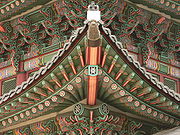
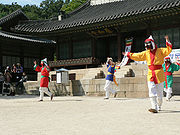


| No. | Title | Original name | Description | Location |
|---|---|---|---|---|
| 32 | Gokseongui dolsilnai | 곡성의돌실나이 (谷城의돌실나이) | Hemp cloth weaving of Gokseong | The Wide area of Jeollanam-do Jeollanam-do Jeollanam-do is a province in the southwest of South Korea. The province was formed in 1896 from the southern half of the former Jeolla province, remained a province of Korea until the country's division in 1945, then became part of South Korea... |
| 33 | Gossaum nori | 광주칠석고싸움놀이 | Gossaum game | The Wide area of Gwangju Gwangju Gwangju is the sixth largest city in South Korea. It is a designated metropolitan city under the direct control of the central government's Home Minister... |
| 34 | Gangnyeong talchum | 강령탈춤 (康翎탈춤) | Mask dance drama of Gangnyeong | The Wide area of Seoul Seoul Seoul , officially the Seoul Special City, is the capital and largest metropolis of South Korea. A megacity with a population of over 10 million, it is the largest city proper in the OECD developed world... |
| 35 | Jogak jang | 조각장 (彫刻匠) | Silver engraving | The Wide area of Seoul Seoul Seoul , officially the Seoul Special City, is the capital and largest metropolis of South Korea. A megacity with a population of over 10 million, it is the largest city proper in the OECD developed world... |
| 38 | Joseon wangjo gungjung eumsik Korean royal court cuisine Korean royal court cuisine was the style of cookery within Korean cuisine traditionally consumed at the court of the Joseon Dynasty, which ruled Korea from 1392 to 1910. There has been a revival of this cookery style in the 21st century... |
조선왕조궁중음식 (朝鮮王朝宮中飮食) | Royal culinary art of the Joseon Dynasty Joseon Dynasty Joseon , was a Korean state founded by Taejo Yi Seong-gye that lasted for approximately five centuries. It was founded in the aftermath of the overthrow of the Goryeo at what is today the city of Kaesong. Early on, Korea was retitled and the capital was relocated to modern-day Seoul... |
The Wide area of Seoul Seoul Seoul , officially the Seoul Special City, is the capital and largest metropolis of South Korea. A megacity with a population of over 10 million, it is the largest city proper in the OECD developed world... |
| 39 | Cheoyongmu Cheoyongmu Cheoyongmu is a representative Korean mask dance based on the legend of Cheoyeong , a son of the Dragon King of the Eastern Sea. It is also the oldest surviving Korean court dance created during the Unified Silla period... |
처용무 (處容舞) | Cheoyong shaman dance | The Wide area of Seoul Seoul Seoul , officially the Seoul Special City, is the capital and largest metropolis of South Korea. A megacity with a population of over 10 million, it is the largest city proper in the OECD developed world... |
| 40 | Hagyeon hwadae hapseolmu | 학연화대합설무 (鶴蓮花臺合設舞) | Muhak crane dance | The Wide area of Seoul Seoul Seoul , officially the Seoul Special City, is the capital and largest metropolis of South Korea. A megacity with a population of over 10 million, it is the largest city proper in the OECD developed world... |
| 41 | Gasa Gasa (poetry) Gasa was a form of poetry popular during the Joseon Dynasty in Korea. They were commonly sung, and were popular among yangban women. Jeong Cheol, a poet of the 16th century, is regarded as having perfected the form, which consisted of parallel lines, each broken into two four-syllable units... |
가사 (歌詞) | Songs | The Wide area of Seoul Seoul Seoul , officially the Seoul Special City, is the capital and largest metropolis of South Korea. A megacity with a population of over 10 million, it is the largest city proper in the OECD developed world... |
| 42 | Akgijang | 악기장 (樂器匠) | Traditional musical instrument making | Nationwide |
| 43 | Suyeong yaryu | 수영야류 (水營野遊) | Masked dance drama of Suyeong | The Wide area of Busan Busan Busan , formerly spelled Pusan is South Korea's second largest metropolis after Seoul, with a population of around 3.6 million. The Metropolitan area population is 4,399,515 as of 2010. It is the largest port city in South Korea and the fifth largest port in the world... |
| 44 | Hanjanggun nori | 한장군놀이 (韓將軍놀이) | General Han's dance and memorial ceremony | The Wide area of Gyeongsangbuk-do Gyeongsangbuk-do Gyeongsangbuk-do or shortly Gyeongbuk is a province in eastern South Korea. The province was formed in 1896 from the northern half of the former Gyeongsang province, remained a province of Korea until the country's division in 1945, then became part of South Korea.The Gyeongsangbuk-do Office is... |
| 45 | Daegeum Daegeum The daegeum is a large bamboo transverse flute used in traditional Korean music. It has a buzzing membrane that gives it a special timbre... sanjo Sanjo (music) Sanjo, literally meaning 'scattered melodies' and is a style of traditional Korean music, involving an instrumental solo accompanied by drumming on the janggu, an hourglass-shaped drum... |
대금산조 (大금散調) | solo performance of the daegeum Daegeum The daegeum is a large bamboo transverse flute used in traditional Korean music. It has a buzzing membrane that gives it a special timbre... (bamboo transverse flute) |
Nationwide |
| 46 | Piri jeongak mit Daechwita | 피리정악및대취타 (피리정악및大吹打) | daechwita Daechwita Daechwita is a genre of Korean traditional music consisting of military music played by wind and percussion instruments, generally performed while marching... royal military march |
The Wide area of Seoul Seoul Seoul , officially the Seoul Special City, is the capital and largest metropolis of South Korea. A megacity with a population of over 10 million, it is the largest city proper in the OECD developed world... |
| 47 | Gungsijang | 궁시장 (弓矢匠) | Korean bow and arrow making | Nationwide |
| 48 | Dancheongjang | 단청장 (丹靑匠) | crafts or craftsman making dancheong Dancheong Dancheong refers to Korean traditional decorative coloring on wooden buildings and artifacts for the purpose of style. It literally means "cinnabar and blue-green" in Korean.... , ornamental painting for buildings. |
Nationwide |
| 49 | Songpa Sandae Noli Songpa Sandae Noli Songpa Sandae Noli is a type of sandae noli, Korean traditional mask play which has been handed down in the neighborhoods of Songpa-dong and Garak-dong in modern-day Seoul, South Korea... |
송파산대놀이 (松坡山臺놀이) | Sandae noli Sandae noli Korean mask dance dramas come in several regional variants, one of which is the sandae noli variant. According to some scholars sandae noli may be the root form of many other Korean mask dance dramas today, as it was created and managed by the Sandae Dogam, a government office in charge of... is a mask dance drama of the Songpa region |
The Wide area of Seoul Seoul Seoul , officially the Seoul Special City, is the capital and largest metropolis of South Korea. A megacity with a population of over 10 million, it is the largest city proper in the OECD developed world... |
| 50 | Yeongsanjae | 영산재 (靈山齋) | Yeongsanjae is a Buddhist rite | The Wide area of Seoul Seoul Seoul , officially the Seoul Special City, is the capital and largest metropolis of South Korea. A megacity with a population of over 10 million, it is the largest city proper in the OECD developed world... |
| 51 | Namdo deullorae | 남도들노래 (南道들노래) | Farmers' songs of Jeolla-do | The Wide area of Jeollanam-do Jeollanam-do Jeollanam-do is a province in the southwest of South Korea. The province was formed in 1896 from the southern half of the former Jeolla province, remained a province of Korea until the country's division in 1945, then became part of South Korea... |
| 53 | Chaesang jang | 채상장 (彩箱匠) | Bamboo cases with colored designs | The Wide area of Jeollanam-do Jeollanam-do Jeollanam-do is a province in the southwest of South Korea. The province was formed in 1896 from the southern half of the former Jeolla province, remained a province of Korea until the country's division in 1945, then became part of South Korea... |
| 55 | Somok jang | 소목장 (小木匠) | Somok, furniture making | Nationwide |
| 56 | Jongmyo jerye Jongmyo jerye Jongmyo Jerye or Jongmyo Daeje is a rite held for worshipping the late kings and queens of the Joseon Dynasty in Jongmyo Shrine, Seoul, South Korea. It is held every year on the first Sunday of May. The Jongmyo rite is usually accompanied with the court music playing and dance called Ilmu or line... |
종묘제례 (宗廟祭禮) | Jongmyo Jongmyo Jongmyo is a Confucian shrine dedicated to the memorial services for the deceased kings and queens of the Korean Joseon Dynasty. According to UNESCO, the shrine is the oldest royal Confucian shrine preserved and the ritual ceremonies continue a tradition established since the 14th century... royal ancestral memorial ceremony |
The Wide area of Seoul Seoul Seoul , officially the Seoul Special City, is the capital and largest metropolis of South Korea. A megacity with a population of over 10 million, it is the largest city proper in the OECD developed world... |
| 57 | Gyeonggi minyo | 경기민요 (京畿民謠) | Folk songs of Gyeonggi-do | The Wide area of Seoul Seoul Seoul , officially the Seoul Special City, is the capital and largest metropolis of South Korea. A megacity with a population of over 10 million, it is the largest city proper in the OECD developed world... |
| 58 | Jultagi Jultagi Jultagi or eoreum is traditional Korean performance of tightrope-walking. It is included into South Korea's Important Intangible Cultural Properties number 58.-Origin:... |
줄타기 | Tightrope walking Tightrope walking Tightrope walking is the art of walking along a thin wire or rope, usually at a great height. One or more artists performs in front of an audience or as a publicity stunt... |
The Wide area of Gyeonggi-do Gyeonggi-do Gyeonggi-do is the most populous province in South Korea. The provincial capital is located at Suwon. Seoul—South Korea's largest city and national capital—is located in the heart of the province, but has been separately administered as a provincial-level special city since 1946... |
| 60 | Jangdo jang | 장도장 (粧刀匠) | Making small swords | The Wide area of Jeollanam-do Jeollanam-do Jeollanam-do is a province in the southwest of South Korea. The province was formed in 1896 from the southern half of the former Jeolla province, remained a province of Korea until the country's division in 1945, then became part of South Korea... |
| 61 | Eunyul talchum Eunyul talchum The Eunyul talchum is a type of talchum, Korean traditional mask drama which has been handed down in Eunyul, Hwanghae Province, present North Korea. It is also one of sandaenori is a mask dance that developed in Seoul and the mid of metropolitan region. It is designated as the No... |
은율탈춤 (殷栗탈춤) | Masked dance drama of originally Eunyul region, Hwanghae Province | The Wide area of Incheon Incheon The Incheon Metropolitan City is located in northwestern South Korea. The city was home to just 4,700 people when Jemulpo port was built in 1883. Today 2.76 million people live in the city, making it Korea’s third most populous city after Seoul and Busan Metropolitan City... |
| 62 | Jwasuyeong eobang nori | 좌수영어방놀이 (左水營漁坊놀이) | Jwasuyeong fishing village rite and festival for big catch | The Wide area of Busan Busan Busan , formerly spelled Pusan is South Korea's second largest metropolis after Seoul, with a population of around 3.6 million. The Metropolitan area population is 4,399,515 as of 2010. It is the largest port city in South Korea and the fifth largest port in the world... |
Proclaimed 1980-1989



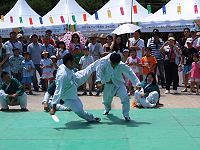

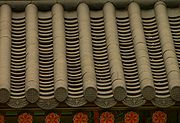
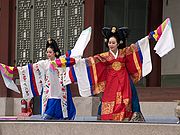
| No. | Title | Original name | Description | Location | |||
|---|---|---|---|---|---|---|---|
| 64 | Duseok jang | 두석장(豆錫匠) | Metal craftsman | Nationwide | |||
| 65 | Baekdong yeonjuk jang | 백동연죽장(白銅煙竹匠) | Nickel smoking-pipe making | The Wide area of Jeollabuk-do Jeollabuk-do Jeollabuk-do is a province in the southwest of South Korea. The province was formed in 1896 from the northern half of the former Jeolla province, and remained a province of Korea until the country's division in 1945, then became part of South Korea... |
|||
| 66 | Manggeonjang | 망건장(網巾匠) | Making manggeon headband | The Wide area of Jeju-do Jeju-do Jeju-do is the only special autonomous province of South Korea, situated on and coterminous with the country's largest island. Jeju-do lies in the Korea Strait, southwest of Jeollanam-do Province, of which it was a part before it became a separate province in 1946... |
|||
| 67 | Tanggeonjang | 탕건장(宕巾匠) | Making Tanggeon hat | The Wide area of Jeju-do Jeju-do Jeju-do is the only special autonomous province of South Korea, situated on and coterminous with the country's largest island. Jeju-do lies in the Korea Strait, southwest of Jeollanam-do Province, of which it was a part before it became a separate province in 1946... |
|||
| 68 | Miryang baekjung nori | 밀양백중놀이(密陽百中놀이) | Baekjungnori of Miryang | Miryang-si, Gyeongsangnam-do Gyeongsangnam-do Gyeongsangnam-do is a province in the southeast of South Korea. The provincial capital is located at Changwon. It contains the major metropolitan center and port of Busan. Located there is UNESCO World Heritage Site Haeinsa, a Buddhist temple that houses the Tripitaka Koreana and attracts many... |
|||
| 69 | Hahoe byeolsingut talnori | 하회별신굿탈놀이(河回別神굿탈놀이) | Byeolsin, masked dance drama of Hahoe | The Wide area of Gyeongsangbuk-do Gyeongsangbuk-do Gyeongsangbuk-do or shortly Gyeongbuk is a province in eastern South Korea. The province was formed in 1896 from the northern half of the former Gyeongsang province, remained a province of Korea until the country's division in 1945, then became part of South Korea.The Gyeongsangbuk-do Office is... |
|||
| 70 | Yangju sonorigut | 양주소놀이굿 | Cow play with shaman exorcism of Yangju Yangju Yangju is a city in Gyeonggi Province, South Korea. Yangju is located south of Dongducheon and north of Uijeongbu not far from Seoul.- Attractions:... |
The Wide area of Gyeonggi-do Gyeonggi-do Gyeonggi-do is the most populous province in South Korea. The provincial capital is located at Suwon. Seoul—South Korea's largest city and national capital—is located in the heart of the province, but has been separately administered as a provincial-level special city since 1946... |
|||
| 71 | Jeju chilmeoridang gut | 제주칠머리당굿(濟州칠머리당굿) | Jeju-do Jeju-do Jeju-do is the only special autonomous province of South Korea, situated on and coterminous with the country's largest island. Jeju-do lies in the Korea Strait, southwest of Jeollanam-do Province, of which it was a part before it became a separate province in 1946... island Chilmeoridang shrine Shrine A shrine is a holy or sacred place, which is dedicated to a specific deity, ancestor, hero, martyr, saint, daemon or similar figure of awe and respect, at which they are venerated or worshipped. Shrines often contain idols, relics, or other such objects associated with the figure being venerated.... shaman exorcism Exorcism Exorcism is the religious practice of evicting demons or other spiritual entities from a person or place which they are believed to have possessed... |
The Wide area of Jeju-do Jeju-do Jeju-do is the only special autonomous province of South Korea, situated on and coterminous with the country's largest island. Jeju-do lies in the Korea Strait, southwest of Jeollanam-do Province, of which it was a part before it became a separate province in 1946... |
|||
| 72 | Jindo ssitgimgut | 진도씻김굿(珍島씻김굿) | Jindo island Jindo Jindo may refer to:* Jindo Island, a South Korean island* Jindo County, a South Korean county, consisting largely of Jindo Island* Korea Jindo Dog, a breed of dog indigenous to Jindo Island... Ssitgimgut shaman exorcism |
The Wide area of Jeollanam-do Jeollanam-do Jeollanam-do is a province in the southwest of South Korea. The province was formed in 1896 from the southern half of the former Jeolla province, remained a province of Korea until the country's division in 1945, then became part of South Korea... |
|||
| 73 | Gasan ogwangdae | 가산오광대(駕山五廣大) | Five masked performers' dance drama of the Gasan region | The Wide area of Gyeongsangnam-do Gyeongsangnam-do Gyeongsangnam-do is a province in the southeast of South Korea. The provincial capital is located at Changwon. It contains the major metropolitan center and port of Busan. Located there is UNESCO World Heritage Site Haeinsa, a Buddhist temple that houses the Tripitaka Koreana and attracts many... |
|||
| 74 | Daemokjang | 대목장(大木匠) | Traditional wooden architecture | Nationwide | |||
| 75 | Gijisi juldarigi | 기지시줄다리기 (機池市줄다리기) | Juldarigi means tug-of-war in native Korean Korean language Korean is the official language of the country Korea, in both South and North. It is also one of the two official languages in the Yanbian Korean Autonomous Prefecture in People's Republic of China. There are about 78 million Korean speakers worldwide. In the 15th century, a national writing... , and the nori (game) originated in the Gijisi region, Dangjin, Chungcheongnam-do Chungcheongnam-do Chungcheongnam-do or Chungnam is a province in the west of South Korea. The province was formed in 1896 from the south-western half of the former Chungcheong Province and remained a province of Korea until the country's division in 1945, thereafter becoming part of South Korea... |
The Wide area of Chungcheongnam-do Chungcheongnam-do Chungcheongnam-do or Chungnam is a province in the west of South Korea. The province was formed in 1896 from the south-western half of the former Chungcheong Province and remained a province of Korea until the country's division in 1945, thereafter becoming part of South Korea... |
|||
| 76 | Taekkyeon | 택견 | Taekkyeon martial art | The Wide area of Chungcheongbuk-do Chungcheongbuk-do Chungcheongbuk-do is a province in the centre of South Korea. It was formed in 1896 from the northeastern half of the former Chungcheong province... |
|||
| 77 | Yugijang | 유기장(鍮器匠) | brassware artisans | Nationwide | |||
| 78 | Ipsajang | 입사장(入絲匠) | Silver wire inlaying | The Wide area of Seoul Seoul Seoul , officially the Seoul Special City, is the capital and largest metropolis of South Korea. A megacity with a population of over 10 million, it is the largest city proper in the OECD developed world... |
|||
| 79 | Baltal | 발탈 | Puppet placed on and manipulated by the foot | Nationwide | |||
| 80 | Jasujang | 자수장(刺繡匠) | Embroidery | Nationwide | |||
| 81 | Jindo dasiraegi | 진도다시래기(珍島다시래기) | Dasiraegi play of Jindo island | The Wide area of Jeollanam-do Jeollanam-do Jeollanam-do is a province in the southwest of South Korea. The province was formed in 1896 from the southern half of the former Jeolla province, remained a province of Korea until the country's division in 1945, then became part of South Korea... |
|||
| 82 | Pungeoje | 풍어제(豊漁祭) | Rite and festivals for big catch of fish | Nationwide | |||
| 82-1 | Donghaean byeolsin gut | 동해안별신굿 | Byeolsingut of the eastern coast | The Wide area of Myeoncheondugyeonju]] | 면천두견주 | Azalea petal wine of Myeoncheon | The Wide area of [[Chungcheongnam-do]] |
| 86-3 | [[Beopju | The Wide area of Gyeonggi-do Gyeonggi-do Gyeonggi-do is the most populous province in South Korea. The provincial capital is located at Suwon. Seoul—South Korea's largest city and national capital—is located in the heart of the province, but has been separately administered as a provincial-level special city since 1946... |
|||||
| 99 | Sobanjang | 소반장(小盤匠) | Tray-table carpentry | The Wide area of Seoul Seoul Seoul , officially the Seoul Special City, is the capital and largest metropolis of South Korea. A megacity with a population of over 10 million, it is the largest city proper in the OECD developed world... |
|||
| 100 | Okjang | 옥장(玉匠) | Jade craftsmanship | The Wide area of Jeollanam-do Jeollanam-do Jeollanam-do is a province in the southwest of South Korea. The province was formed in 1896 from the southern half of the former Jeolla province, remained a province of Korea until the country's division in 1945, then became part of South Korea... |
|||
| 101 | Geumsokhwalja jang | 금속활자장 | Art of movable metal type | The Wide area of Chungcheongbuk-do Chungcheongbuk-do Chungcheongbuk-do is a province in the centre of South Korea. It was formed in 1896 from the northeastern half of the former Chungcheong province... |
|||
| 102 | Baecheopjang | 배첩장 | Mounting | The Wide area of Seoul Seoul Seoul , officially the Seoul Special City, is the capital and largest metropolis of South Korea. A megacity with a population of over 10 million, it is the largest city proper in the OECD developed world... |
|||
| 103 | Wanchojang | 완초장 | Sedge work (making mats, cushions, mattresses, bowls, and baskets from sedge plants) | The Wide area of Incheon Incheon The Incheon Metropolitan City is located in northwestern South Korea. The city was home to just 4,700 people when Jemulpo port was built in 1883. Today 2.76 million people live in the city, making it Korea’s third most populous city after Seoul and Busan Metropolitan City... |
|||
| 104 | Seoul Saenam gut | 서울새남굿 | Shaman rite of Seoul for guiding a departed spirit into the land of bliss | The Wide area of Seoul Seoul Seoul , officially the Seoul Special City, is the capital and largest metropolis of South Korea. A megacity with a population of over 10 million, it is the largest city proper in the OECD developed world... |
|||
| 105 | Sagijang | 사기장 | Art of ceramics | The Wide area of Gyeongsangbuk-do Gyeongsangbuk-do Gyeongsangbuk-do or shortly Gyeongbuk is a province in eastern South Korea. The province was formed in 1896 from the northern half of the former Gyeongsang province, remained a province of Korea until the country's division in 1945, then became part of South Korea.The Gyeongsangbuk-do Office is... |
|||
| 106 | Gakjajang | 각자장 | Calligraphic engraving | The Wide area of Seoul Seoul Seoul , officially the Seoul Special City, is the capital and largest metropolis of South Korea. A megacity with a population of over 10 million, it is the largest city proper in the OECD developed world... |
|||
| 107 | Nubijang | 누비장 | Quilting | The Wide area of Gyeongsangnam-do Gyeongsangnam-do Gyeongsangnam-do is a province in the southeast of South Korea. The provincial capital is located at Changwon. It contains the major metropolitan center and port of Busan. Located there is UNESCO World Heritage Site Haeinsa, a Buddhist temple that houses the Tripitaka Koreana and attracts many... |
|||
| 108 | Mokjogakjang | 목조각장 | Wood sculpture | The Wide area of Gyeonggi-do Gyeonggi-do Gyeonggi-do is the most populous province in South Korea. The provincial capital is located at Suwon. Seoul—South Korea's largest city and national capital—is located in the heart of the province, but has been separately administered as a provincial-level special city since 1946... |
|||
| 109 | Hwagakjang | 화각장 | Ox horn inlaying | The Wide area of Incheon Incheon The Incheon Metropolitan City is located in northwestern South Korea. The city was home to just 4,700 people when Jemulpo port was built in 1883. Today 2.76 million people live in the city, making it Korea’s third most populous city after Seoul and Busan Metropolitan City... |
|||
| 110 | Yundojang | 윤도장 | Making geomantic compasses | The Wide area of Jeollabuk-do Jeollabuk-do Jeollabuk-do is a province in the southwest of South Korea. The province was formed in 1896 from the northern half of the former Jeolla province, and remained a province of Korea until the country's division in 1945, then became part of South Korea... |
Proclaimed 2000-2009

| No. | Title | Original name | Description | Location |
|---|---|---|---|---|
| 111 | Sajik daeje | 사직대제 | Ceremony for ancestors | The Wide area of Seoul Seoul Seoul , officially the Seoul Special City, is the capital and largest metropolis of South Korea. A megacity with a population of over 10 million, it is the largest city proper in the OECD developed world... |
| 112 | Jucheoljang | 주철장 | Cast iron Cast iron Cast iron is derived from pig iron, and while it usually refers to gray iron, it also identifies a large group of ferrous alloys which solidify with a eutectic. The color of a fractured surface can be used to identify an alloy. White cast iron is named after its white surface when fractured, due... |
Seocho-gu Seocho-gu Seocho-gu is a gu of Seoul, South Korea. It is a popular residential area for the mid- or upper-class residents in Seoul and home to the Supreme Court and the Supreme Prosecutors' Office. Seocho Samsung Town in Seocho-dong, near Gangnam Station, is the headquarter of the several corporations of the... , Seoul Seoul Seoul , officially the Seoul Special City, is the capital and largest metropolis of South Korea. A megacity with a population of over 10 million, it is the largest city proper in the OECD developed world... |
| 113 | Chiljang | 칠장 | Lacquer work | Dobong-gu Dobong-gu Dobong-gu is one of the 25 districts of Seoul, South Korea. It is located on the north side of the Han River.-Mountain:Donbong Mt. is nearby and actually its area is in charge of dobong-gu.... , Seoul Seoul Seoul , officially the Seoul Special City, is the capital and largest metropolis of South Korea. A megacity with a population of over 10 million, it is the largest city proper in the OECD developed world... |
| 114 | Yeomjang | 염장 | Bamboo Bamboo Bamboo is a group of perennial evergreens in the true grass family Poaceae, subfamily Bambusoideae, tribe Bambuseae. Giant bamboos are the largest members of the grass family.... blind Window blind A window blind is a type of window coverings. There are many different kinds of window blinds, using different systems and materials. A typical window blind is made with slats of fabric, wood, plastic or metal that adjust by rotating from an open position to a closed position by allowing slats to... making |
Tongyeong-si, Gyeongsangnam-do]] |
| 115 | Yeomsaekjang | 염색장 | Dyeing | Naju-si, Jeollanam-do Jeollanam-do Jeollanam-do is a province in the southwest of South Korea. The province was formed in 1896 from the southern half of the former Jeolla province, remained a province of Korea until the country's division in 1945, then became part of South Korea... |
| 116 | Hwahyejang | 화혜장 | Making traditional Korean shoes | Songpa-gu Songpa-gu Songpa-gu is a district of Seoul, South Korea. Songpa is located at the southeastern part of Seoul, the capital of Korea, Songpa is a district with the largest population... , Seoul Seoul Seoul , officially the Seoul Special City, is the capital and largest metropolis of South Korea. A megacity with a population of over 10 million, it is the largest city proper in the OECD developed world... |
| 117 | Hanjijang | 한지장 | Making traditional Korean paper Korean paper Korean paper or hanji is the name of traditional handmade paper from Korea. Hanji is made from the inner bark of Paper Mulberry, a tree native to Korea that grows well on its rocky mountainsides, known in Korean as dak. The formation aid crucial to making hanji is the mucilage that oozes from the... |
The Wide area of Gyeonggi-do Gyeonggi-do Gyeonggi-do is the most populous province in South Korea. The provincial capital is located at Suwon. Seoul—South Korea's largest city and national capital—is located in the heart of the province, but has been separately administered as a provincial-level special city since 1946... |
| 118 | Bulhwajang | 불화장 | Buddhist painting, designated on January 10, 2006 | Nationwide |
| 119 | Geumbakjang | 금박장 | Gold leaf Gold leaf right|thumb|250px|[[Burnishing]] gold leaf with an [[agate]] stone tool, during the water gilding processGold leaf is gold that has been hammered into extremely thin sheets and is often used for gilding. Gold leaf is available in a wide variety of karats and shades... decoration for hanbok Hanbok Hanbok or Chosŏn-ot is the traditional Korean dress. It is often characterized by vibrant colors and simple lines without pockets. Although the term literally means "Korean clothing", hanbok today often refers specifically to hanbok of Joseon Dynasty and is worn as semi-formal or formal wear... , designated on November 16, 2006 |
Seongnam Seongnam Seongnam is the second largest city in South Korea's Gyeonggi province after Suwon and the 9th largest city in the country, with a population of nearly 1 million... , Gyeonggi-do Gyeonggi-do Gyeonggi-do is the most populous province in South Korea. The provincial capital is located at Suwon. Seoul—South Korea's largest city and national capital—is located in the heart of the province, but has been separately administered as a provincial-level special city since 1946... |
See also
- National Treasures of South KoreaNational treasures of South KoreaThe National Treasures of Korea are a numbered set of tangible treasures, artifacts, sites, and buildings which are recognized by South Korea as having exceptional artistic, cultural and historical value...
- Intangible culture
- Cultural heritage managementCultural Heritage ManagementCultural heritage management is the vocation and practice of managing cultural heritage. It is a branch of cultural resources management , although it also draws on the practices of conservation, restoration, museology, archaeology, history and architecture...
- Cultural resources managementCultural resources managementIn the broadest sense, Cultural Resources Management is the vocation and practice of managing cultural resources, such as the arts and heritage. It incorporates Cultural Heritage Management which is concerned with traditional and historic culture. It also delves into the material culture of...
- Cultural heritageCultural heritageCultural heritage is the legacy of physical artifacts and intangible attributes of a group or society that are inherited from past generations, maintained in the present and bestowed for the benefit of future generations...
- Living National TreasureLiving National TreasureLiving National Treasure or Living Human Treasure is a title awarded in several countries, and denotes a person or a group which is regarded as a national treasure while still alive....
- Living National Treasure (Japan)Living National Treasure (Japan)is a Japanese popular term for those individuals certified as by the Minister of Education, Culture, Sports, Science and Technology as based on Japan's...

